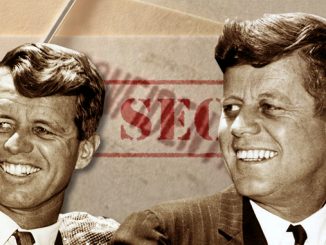
Multiple researchers are examining the similarities of the assassination operations that took out President John F. Kennedy, Sen. Robert F. Kennedy, and Rev. Dr. Martin Luther King Jr. These researchers, explains S. T. Patrick, “are not fringe theorists. In many ways, they are human encyclopedias of assassination and conspiracy.” Listen to his interview with author Carmine Savastano.
By S. T. Patrick
The assassinations of President John F. Kennedy, Sen. Robert F. Kennedy, and Rev. Dr. Martin Luther King Jr. have for decades been taught and written about in isolation. While the Kennedy brothers shared familial, political, and relational ties, the murders are still viewed as separate events. Though the deaths of RFK and MLK are separated by only two months, the means, motives, and opportunities that dictate criminal and legal investigations have never been woven together by the historical and educational establishment.
The tendency of the educational theorists and textbook conglomerates to isolate characters and events in history is understood—if not excused. By avoiding patterns and minimizing links, history can be taught as a series of spontaneous events that create patriotic heroes, ignite societal changes, and provide government-based solutions.
If the shared players, government agencies, behavioral patterns, and deep politics behind these seminal assassinations were highlighted, students as well as casual observers would begin questioning the structure of power that exists in America today. The survival of the richest would then be questioned with historical ferocity, the likes of which would be unparalleled.
In 2003, Jim DiEugenio and Lisa Pease coauthored and co-edited an anthology entitled The Assassinations: Probe Magazine on JFK, MLK, RFK, and Malcolm X. DiEugenio wrote that he and Pease “thought it was wrong to survey them only as individual incidents. They were related to each other, especially in their cumulative impact.”
DiEugenio, writing for “KennedysandKing.com,” noted that the impact of the assassinations was two-fold. First, the relative success of the JFK assassins buoyed the confidence of the perpetrators and encouraged them to carry out the other assassinations. Second, it was the literal death of the liberal left in the country.
Obvious in the three assassinations is the identification of a “lone nut” archetype, a killer who had been taken past his emotional peak by an ideological issue. For Lee Harvey Oswald, we were taught to believe it was Oswald’s hatred of an American way of life and a devotion to communism. For James Earl Ray, it was the weight of his criminal background and stereotypical Southern racism. Sirhan Sirhan, we were told, was motivated by his devotion to the allegedly anti-Semitic pro-Palestinian movement. He assassinated Bobby Kennedy because RFK had promised fighter jets to Israel, if elected. Critical researchers now contest all of these motives, most of which have been proven false by documents and interviews after the official reports were released.
We now know that Oswald had surrounded himself with rabid anti-communists in both New Orleans and Dallas. In New Orleans, he worked out of the same Camp Street office as the communist-hating Guy Bannister and in Dallas was befriended by a White (anti-communist) Russian, George De Mohrenschildt. Ray has a sparse history of racism and very few actions that can be tied to an innate, inescapable criminal personality. Sirhan was not an anti-Semitic follower of Islam. He was a Greek Orthodox Christian who had been brought to America by Christian missionaries. When Sirhan’s home was searched immediately after the assassination, no library of pro-Palestinian information was found.
Rep. Allard K. Lowenstein (D-N.Y.) once said, “What is odd is not that some people thought [the Kennedy brothers’ assassinations were] random, but that so many intelligent people refused to believe that it might be anything else.”
The newest attempt at understanding these assassinations in tandem as a foundational and structural problem is Carmine Savastano’s Two Princes and a King: A Concise Review of Three Political Assassinations. Savastano looks at the errors, incompetence, and inaction of each investigation, as well as the generalized groups that may bear some responsibility.
Savastano examines potential culprits in the categories of underworld arm (criminal elements, including mob involvement), official arm (elected and appointed officials), military intelligence arm (including CIA), and the conspirators (those actually involved at ground level). In doing so, Savastano is identifying uniquely different patterns of operation and cover-up that exist within each element.
DiEugenio, Pease, and Savastano are not fringe theorists. In many ways, they are human encyclopedias of assassination and conspiracy. They do not agree on every source, nor do they agree on the importance of every revelation, but that is the norm for research communities. They have all, however, brought forth information and conclusions that are vital in understanding the assassinations of three transformative leaders of the 1960s. Most importantly, all three are replacing what Americans were told they must believe with what actually was, one detail, one interview, and one document at a time.
At the 50th anniversary of the MLK and RFK assassinations, it is more important and more possible than ever to look at patterns and connections in a more cogent, identifiable way. Independent researchers, authors, and content providers will continue to do what the historical aristocrats of academia and a failed educational system have not done. They will dredge through the mounds of bad historiography and ineffectual government reports in search of meaning and in search of truth.
S.T. Patrick holds degrees in both journalism and social studies education. He spent 10 years as a respected educator and now hosts the “Midnight Writer News Show.” You may email him at [email protected].
Ed. Note: This article was originally published in American Free Press Issue 11 & 12, March 12 & 19, 2018.




I believe these assassinations are related. Probably the CIA.
AFP has republished Mr. Piper’s famed book on the JFK assassination. Copies can be ordered from our store. Click here to learn more.
If you can find a copy, read “Final Judgment” by Michael Collins Piper. It goes into all three assassinations extremely well, as well as that of JFK Jr. What he didn’t know about President Kennedy’s assassination was that E. Howard Hunt and Frank Sturgis both confessed to being on the Grassy Knoll, as they were dying. Sturgis fought in Israel’s war of 1948, came to the U.S. and became a CIA assassin. Hunt said he did not fire; Sturgis did not say that.
Just for the record Sirhan Sirhan didn’t shoot RFK. The security guard Thane Eugene Cesar fired the fatal head shot from RFK’s right rear at point-blank range. This has been proven beyond a reasonable doubt…… Sirhan supposedly shot RFK because of his ‘support’ for Israel. Funny, a Palestinian, really. The Israeli’s really think us Goyim are complete imbeciles.
Sirhan was not only an atheist but was obsessed with the occult. He was also a rabid anti-Semite if anyone who cares to research his background will discover.
http://archive.frontpagemag.com/readArticle.aspx?ARTID=8641
Hmmm. So I just have to comment on this headline. The answer is yes and no. JFK and RFK were killed by Israeli Mossad with the help of the CIA, FBI and the Pentagon. MLK was killed by the FBI and Military intelligence with the help of the Memphis P.D. and “Dr. Breen Bland, chief of surgery at St. Joseph’s Hospital with two men in suits”, in Memphis.